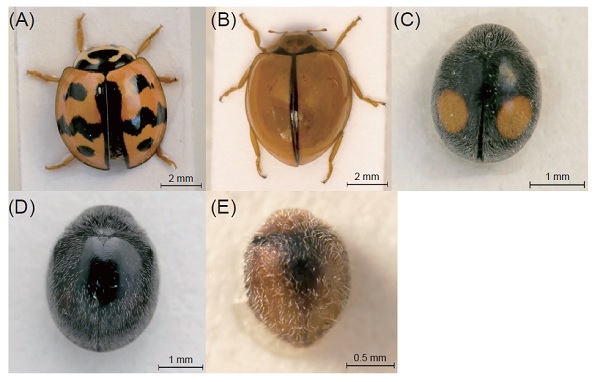All issues

Author:Yaw-Jen Dong, Wan-Hsiu Yang*, Pei-Chen Hsu*, Chi-Feng Lee, Mei-Jung Tseng, Jen-Yu Chang, Chi-Ling Chen, and Hsien-Tzung Shih
Abstract:
This study presents the results of a survey of different lady beetle species in field areas under various agricultural practices using the yellow sticky paper method in 11 agricultural monitoring stations, including the Madou pomelo fruit orchard, from 2020 to 2022. A total of 68 lady beetle species belonging to 8 subfamilies, 11 tribes, and 32 genera were identified, among which the subfamily Coccinellinae and tribe Coccinellini had the highest number of species, with 26 species of lady beetles. Five species of lady beetle- Cheilomenes sexmaculata (Fabricius, 1781), Cryptogonus orbiculus (Gyllenhal, 1808), Illeis koebelei (Timberlake, 1943), Propylea japonica (Thunberg, 1781), and Sasajiscymnus tainanensis (Ohta, 1929), had the widest distribution and were found in all 11 agricultural monitoring stations. The dominant lady beetle species in different rice fields were Micraspis discolor (Fabricius, 1798) and Ch. Sexmaculata. In fruit orchards under different farming practices, the dominant lady beetle species were Cr. Orbiculus, Sa. Tainanensis, Ch. Sexmaculata, and Scymnus centralis Kamiya, 1965. Organic fruit orchards demonstrated a higher diversity and quantity of lady beetles compared to conventionally cultivated orchards. The occurrence of lady beetle species and their quantities varied in different rice fields. Among the 11 agricultural monitoring stations surveyed, 9 organic monitoring stations had higher lady beetle diversity than conventionally monitoring stations. These findings revealed the species composition of lady beetles and identified the dominant species in various agricultural regions. Notably, Sa. tainanensis exhibited the broadest distribution and was the predominant species across most areas. These results will be useful in the development and implementation of future biological control management programs.
Key words:Lady beetle, Agricultural monitoring stations, Conventional cultivated, Organic cultivated, Long term ecological research
Download:![]() PDF Links
PDF Links
- 1. Using Digital Soil Mapping to Predict Soil Organic Carbon Stocks in Zhuoshui River Basin
- 2. Taxonomic Review of the Genus Asiophrida Medvedev, 1999 in Taiwan (Insecta: Coleoptera: Chrysomelidae: Galerucinae: Alticini), with Notes on Biology
- 3. Development of a Technique for Forecasting (or Pre-Detection) Anthracnose Disease Incidences of Green Mature Bagging Mango Fruits
 Submit your manuscript
Submit your manuscript
 Guide for authors
Guide for authors